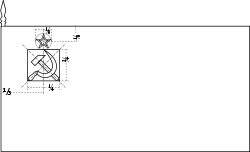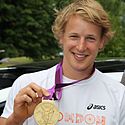Epke Zonderland
| Epke Zonderland | ||||||||||||||||||||||||||||||||||||||||||||||||||||
 Epke Zonderland mit seiner olympischen Goldmedaille von 2012 | ||||||||||||||||||||||||||||||||||||||||||||||||||||
| Persönliche Informationen | ||||||||||||||||||||||||||||||||||||||||||||||||||||
| Name: | Epke Jan Zonderland | |||||||||||||||||||||||||||||||||||||||||||||||||||
| Nationalität: | ||||||||||||||||||||||||||||||||||||||||||||||||||||
| Disziplin | Gerätturnen | |||||||||||||||||||||||||||||||||||||||||||||||||||
| Spezialgerät/e: | ||||||||||||||||||||||||||||||||||||||||||||||||||||
| Verein: | Turncentrum Sportstad Heerenveen | |||||||||||||||||||||||||||||||||||||||||||||||||||
| Trainer: | Daniel Knibbeler | |||||||||||||||||||||||||||||||||||||||||||||||||||
| Geburtstag: | 16. April 1986 | |||||||||||||||||||||||||||||||||||||||||||||||||||
| Geburtsort: | Lemmer | |||||||||||||||||||||||||||||||||||||||||||||||||||
| Größe: | 173 cm | |||||||||||||||||||||||||||||||||||||||||||||||||||
| Gewicht: | 68 kg | |||||||||||||||||||||||||||||||||||||||||||||||||||
Medaillen
| ||||||||||||||||||||||||||||||||||||||||||||||||||||
Epke Jan Zonderland (* 16. April 1986 in Lemmer) ist ein ehemaliger niederländischer Geräteturner.
Zonderland begann eigenen Angaben zufolge ab dem vierten Lebensjahr mit dem Turnen, nachdem bereits seine Schwester Geeske (* 1981) und seine Brüder Herre (* 1983) und Johan (* 1984) diesem nachgingen. Seine Brüder liefen ebenfalls für das niederländische Nationalteam auf. Seit Verletzungen vor den Olympischen Sommerspielen 2008 in Peking begann sich Zonderland auf die Geräte Barren und Reck zu konzentrieren.[1] In Peking belegte er im Reckfinale einen siebten Platz.
Nach zwei errungenen Silbermedaillen bei Weltmeisterschaften (2009 und 2010) und dem Europameistertitel 2011 an seinem Paradegerät folgte bei den Olympischen Sommerspielen 2012 in London der Olympiasieg am Reck. Es war die erste olympische Medaille im Turnen der Männer für die Niederlande. Zonderland zeigte eine fehlerfreie Darbietung mit hohem Schwierigkeitsgrad (7,9), die drei Twists in Folge beinhaltete und ihm am Ende eine Wertung von 16,533 Punkten einbrachte.[2][3] Ein Jahr später gelang es ihm bei den Weltmeisterschaften in Antwerpen erstmals den Titel am Reck zu gewinnen.
2009, 2011, 2012 und 2013 wurde er in den Niederlanden zum Sportler des Jahres gewählt.
Bei einer Körpergröße von 1,73 Meter[4] betrug Zonderlands Wettkampfgewicht 68 Kilogramm.[5] Er lebt in Heerenveen, wo er Mitglied beim Turncentrum Sportstad Heerenveen (TSH) war und von Daniel Knibbeler trainiert wurde. Neben dem Sport studierte Zonderland Medizin an der Reichsuniversität Groningen.[4] Er beendete sein Studium der Medizin erfolgreich mit dem Abschluss 2018. Zonderlands Spitzname ist „The Flying Dutchman“ (Der fliegende Holländer).
Weblinks
- Epke Zonderland in der Datenbank der Fédération Internationale de Gymnastique (englisch)
- Offizielle Website (niederländisch)
Einzelnachweise
- ↑ Selbstporträt bei epkezonderland.com (niederländisch; abgerufen am 8. Februar 2016).
- ↑ Zonderland wins horizontal bar gold; USA fails to medal bei foxnews.com, 7. August 2012 (abgerufen am 7. August 2012).
- ↑ Joynson, Danielle: Result: Epke Zonderland clinches gold medal for the Netherlands in horizontal bars bei sportsmole.co.uk, 7. August 2012 (abgerufen am 7. August 2012).
- ↑ a b Profil (Memento vom 27. Januar 2013 im Webarchiv archive.today) bei london2012.com (abgerufen am 7. August 2012).
- ↑ Epke Zonderland in der Datenbank der Fédération Internationale de Gymnastique (englisch) (abgerufen am 8. Februar 2016).
| Personendaten | |
|---|---|
| NAME | Zonderland, Epke |
| ALTERNATIVNAMEN | Zonderland, Epke Jan |
| KURZBESCHREIBUNG | niederländischer Geräteturner |
| GEBURTSDATUM | 16. April 1986 |
| GEBURTSORT | Lemmer |
Auf dieser Seite verwendete Medien
Pictograms of Olympic sports - Gymnastics (artistic). This is unofficial sample picture. Images of official Olympic pictograms for 1948 Summer Olympics and all Summer Olympics since 1964 can be found in corresponding Official Reports.
Olympic Rings without "rims" (gaps between the rings), As used, eg. in the logos of the 2008 and 2016 Olympics. The colour scheme applied here was specified in 2023 guidelines.
Flag of the Germans(1866-1871)
Flag of the Germans(1866-1871)
US Flag with 45 stars. In use 4 July 1896–3 July 1908. Created by jacobolus using Adobe Illustrator, and released into the public domain. This flag was used during the Spanish-American War.
US Flag with 45 stars. In use 4 July 1896–3 July 1908. Created by jacobolus using Adobe Illustrator, and released into the public domain. This flag was used during the Spanish-American War.
Pan-Slavic flag. Emerged from 1848 Prague pan-Slavic conference, or interpretations of the resolutions of the conference. Drawn by Fibonacci.
Pan-Slavic flag. Emerged from 1848 Prague pan-Slavic conference, or interpretations of the resolutions of the conference. Drawn by Fibonacci.
Die quadratische Nationalfahne der Schweiz, in transparentem rechteckigem (2:3) Feld.
US Flag with 48 stars. In use for 47 years from July 4, 1912, to July 3, 1959.
Variant version of a flag of Japan, used between January 27, 1870 and August 13, 1999 (aspect ratio 7:10).
Variant version of a flag of Japan, used between January 27, 1870 and August 13, 1999 (aspect ratio 7:10).
(c) I, Cmapm, CC BY-SA 3.0
The flag of the Soviet Union (1955-1991) using a darker shade of red.

(c) I, Cmapm, CC BY-SA 3.0
The flag of the Soviet Union (1955-1991) using a darker shade of red.

Autor/Urheber:
unbekannt
, Lizenz: LogoLogo der FIG
Horizontal Bar
Autor/Urheber: Jladage, Lizenz: CC BY-SA 3.0
Epke Zonderland met Olympisch goud (Londen 2012)



















